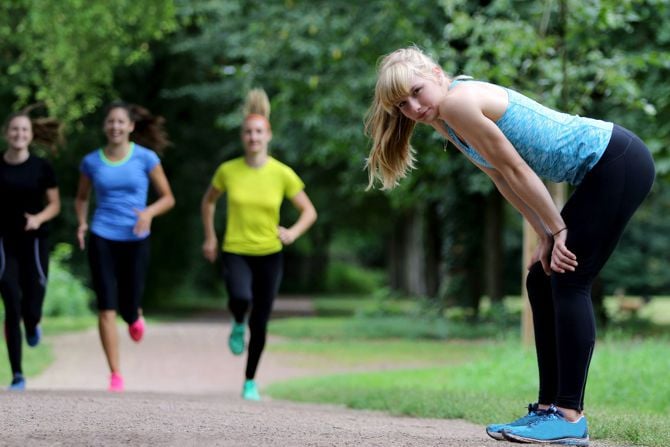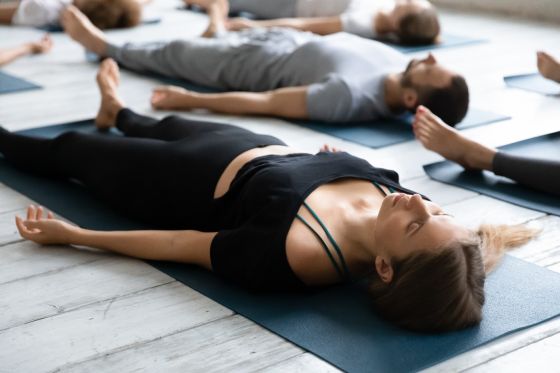Breathing Basics for Runners
Run faster with the optimal breathing technique

Breathing correctly while jogging is actually easy - yet many amateur and even professional athletes occasionally complain of side pain or even get out of step with their breathing. The reasons for this range from shallow everyday breathing to incorrect breathing recommendations. Find out the most important things about breathing technique when jogging and how you can enjoy running without any worries.
- Breathing correctly while jogging - the most important things
- Breathing and running
- The right breathing technique
- Train your diaphragm
- Abdominal pain – what causes it
- Preventing abdominal pain
- Running on cold days
Breathing correctly while jogging - the most important points at a glance
- If you breathe correctly when jogging, you can improve your running performance.
- The optimal breathing technique allows more oxygen into the lungs so that their full capacity can be utilized.
- You can train your lungs and thus increase your vitality.
- Abdominal pain can be avoided.
- You have more fun while running.
- By the way: More than half of all people breathe "incorrectly", i.e. too shallowly - and those who breathe incorrectly in everyday life also breathe incorrectly when running.
Breathing and running - diaphragmatic breathing
First of all, a few facts about breathing: we breathe around 10 to 20 times per minute and even up to 50 times under exertion, for example when jogging. This means that we breathe about twice as often under stress as we do at rest. This shows how important it is to breathe optimally, especially under stress - to feel good on the one hand and to increase your performance level on the other; Diaphragmatic breathing (abdominal breathing) plays a particularly important role in breathing correctly when jogging. And it is precisely this that we criminally neglect in everyday life. This is fatal, because the diaphragm is our most important breathing muscle. Those who breathe well through the diaphragm feel relaxed, have more air and are less likely to suffer from breathlessness. Good diaphragmatic breathing can even prevent anxiety.

Breathing technique when jogging
Breathe deeply through your mouth and nose into your stomach while running. Important: Forget the advice to breathe in only through your mouth or only through your nose. You can tell whether you are really taking a deep breath by whether your abdominal wall bulges upwards and your chest then rises. At this point, you should definitely put all the world's slimming ideals out of your mind. Because if you breathe properly, your belly will show. After inhaling, breathe out freely through your mouth; Contrary to some recommendations, the correct breathing technique when jogging is not linked to steps, but free. Counting steps, such as breathing in for two steps and breathing out for three steps, can even be counterproductive or unconsciously cause stress. It is better to find your own breathing rhythm, perhaps according to the music you like to listen to while running. Because breathing is individual and does not follow a formula; When breathing, also make sure not to raise your shoulders, as this blocks the airflow instead of harmonizing it.

Excursus: training diaphragmatic breathing
Correct breathing is not only essential when jogging, but also helps and inspires us in everyday life. Those who breathe fluently and deeply generally feel more vital and relaxed. The linchpin is the diaphragm. Those who use its potential benefit from greater performance. And those who regularly train diaphragmatic breathing (abdominal breathing) will also feel the positive effects when running.
How to train abdominal breathing:
- Lie relaxed on an exercise mat and place a hand or a light book on your stomach
- Bend your legs slightly and place your feet flat on the floor.
- Breathe deeply into your stomach - your hand or the book should visibly rise and shortly afterwards your chest should rise too.
- Then breathe out deeply so that all the air can escape and your stomach becomes flat again
- If you can do the exercise well lying down, you can also do it sitting up.
Regardless of the correct breathing technique for jogging, the following video will show you how important diaphragmatic breathing is and which technique you can use to relax a tense diaphragm.
Abdominal pain - causes?
You're running like clockwork, but suddenly you feel a twinge in your side and the jogging steps that were just flowing become a struggle. Many athletes are familiar with abdominal pain. The unpleasant pulling sensation during a competition is particularly problematic.
The causes of side stitches have not yet been fully clarified scientifically. However, there are several theories. One possible reason is the already mentioned incorrect or, more precisely, too shallow breathing, known as chest breathing. This means that the diaphragm lacks oxygen, causing it to cramp and ache. However, some scientists argue against this theory, arguing that the diaphragm is one of the most trained muscles and that it is impossible to overexert it.
Another reason for side stitches could be a too full stomach. During sport, the internal organs are supplied with less blood as the blood flow shifts to the muscles. As a result, sensitive organs such as the spleen and liver as well as the surrounding connective tissue become deformed and begin to ache. Digestion also comes to a standstill due to the redistribution of blood. The result: side stitches.
A weak upper body musculature is also suspected of triggering abdominal pain, as is talking while running. So what should be done?

Preventing abdominal pain
Pay particular attention to breathing correctly when running - keyword: diaphragmatic breathing. In addition, start running slowly and gradually increase your pace so that your blood circulation can better adapt to the "activity" mode. Regular training also protects against unpleasant pain in the side. This is because the redistribution of blood can be trained.
In addition, you should not eat for one to two hours before jogging and if you do, then only easily digestible snacks such as bananas. Your stomach should not be too empty or too full. Strengthen your abdominal and back muscles with gymnastics and avoid talking during the run.
If you still feel unpleasant abdominal pain, slow down first and try to continue breathing calmly and evenly. A short break can also help. The pain usually passes quickly. Otherwise, raising your arms or applying a hand with light pressure to the painful area and then breathing against your hand will help.
Breathing when running on cold days
The fact is that the body first has to warm up very cold air in order to be able to utilize it optimally. The more drastic the temperature differences, the more stressed the body is, which can also affect your running performance when jogging.
Nevertheless, temperatures below zero do not automatically mean that joggers have to stay at home. If you are healthy and have no problems with your lungs or bronchial tubes, you can still go jogging in temperatures as low as minus ten degrees.
Regarding correctly breathing when jogging on cold days, you can support your body with the right technique. Breathe deeply into your stomach. Again, involve the diaphragm in your breathing. While you should breathe in through your mouth and nose in normal temperatures, on particularly cold days you should only breathe in through your nose. This way, the cold air does not enter the lungs directly, but has to take a detour via the nose first and can be warmed up in the process. The only disadvantage is that not as much air can flow in through the nose as through the mouth or through the mouth and nose. You should therefore take things slower on cold days to avoid side stitches or shortness of breath. A scarf or shawl in front of your mouth can also ward off cold air.

In addition to a good breathing technique, the right running clothing also contributes to a good running performance - both in winter and summer. The trick is dressing in layers. The warmer it is outside, the fewer layers you need.
On cold days, breathable and windproof clothing is particularly important for heat retention, as are jogging accessories - especially a scarf and hat. And last but not least, running shoes should fit perfectly, provide good cushioning and have a grippy sole with a tread for off-road or snow runs. And it doesn't matter whether it's summer or winter: If you get customized running shirts, it might boost your motivation.
Breathe correctly while jogging
If you breathe properly when jogging, you run better. With a good breathing technique, you can increase both enjoyment and performance. The way we breathe when running is also linked to our breathing in everyday life. Those who consciously or unconsciously breathe deeply through the diaphragm usually have no problems when running. This is because diaphragmatic breathing is the lever for supplying the body with the ideal amount of oxygen and preventing you from getting out of breath or even suffering from side stitches when jogging. If you want to improve your breathing while jogging, you can start by practicing abdominal breathing at rest.
Here are some magazine articles you might be interested in:
Image Credits: Title Image: grafikwerk21 / adobe.stock, Image 1: PheelingsMedia / adobe.stock, Image 2: fizkesm / adobe.stock, Image 3: PiyawatNandeenoparit / adobe.stock, Image 4: luckybusiness / adobe.stock
More magazine articles
© 2024 owayo GmbH. All rights reserved


